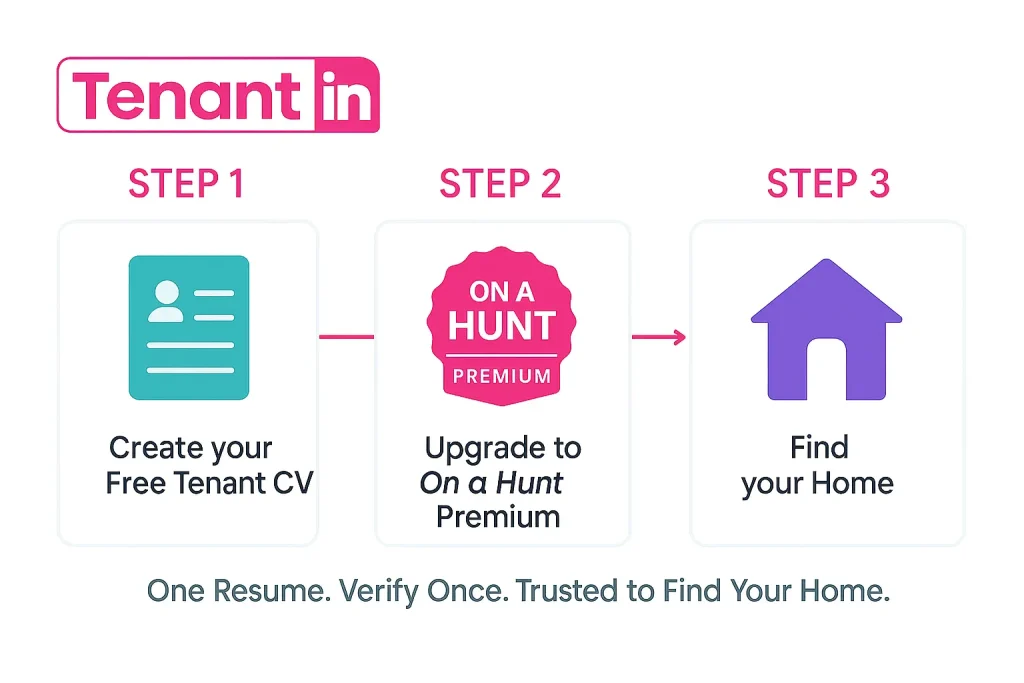Tenant selection is one of the most time-consuming parts of being a landlord in Ireland. With dozens of applicants per property and limited time to assess each one, the vetting process can easily become overwhelming. But what if there was a way to make it faster, easier, and more reliable? That’s where the tenant CV comes in.
At Tenantin.ie, we help renters create professional profiles that landlords can quickly review—cutting down on the back-and-forth and making it easier to spot the ideal tenant. In this post, we’ll explore how landlords can streamline the vetting process using tenant CVs, how to interpret rental history, and why this approach is gaining traction across Ireland.
What Is a Tenant CV?
A tenant CV is a structured rental profile, similar to a job CV. It contains key information about the tenant, including:
- Personal details
- Employment status
- Rental history
- References
- Supporting documents (such as ID and proof of income)
This format allows landlords to quickly assess whether a tenant meets their criteria—without chasing down missing information.
Common Challenges Landlords Face When Vetting
Let’s face it: managing property is already demanding. The vetting process often adds unnecessary delays due to:
- Incomplete or inconsistent applications
- Lack of documentation
- Difficulty verifying income or references
- Tenants not responding promptly
These delays can lead to longer vacancy periods, missed rental income, and frustration for both parties.
Using tenant resumes helps landlords skip these common hurdles.
How Tenant CVs Speed Up the Process
1. All Information in One Place
When tenants use the free resume tool on Tenantin.ie, they provide everything up front:
- ID and contact details
- Employment and income info
- Rental history with landlord contacts
- Personal references
This allows landlords to compare applicants side-by-side without requesting extra documents.
2. Easier Background Checks
Clear, concise rental CVs make it simpler to:
- Contact previous landlords
- Confirm job status
- Verify proof of income
You can spot red flags early or move forward confidently.
3. Faster Communication
With pre-filled CVs, there’s less need to ask tenants follow-up questions. That means less back-and-forth and quicker decisions.
4. Better First Impressions
Tenants who submit a professional CV demonstrate seriousness and organisation. This saves landlords time sifting through vague or incomplete emails.

What to Look for in a Strong Tenant CV
As a landlord, focus on these key indicators:
- Consistent rental history: Long stays and no gaps suggest reliability.
- Steady employment: Whether salaried or self-employed, regular income is a good sign.
- References: Look for at least one from a past landlord or employer.
- Clear documentation: Pay slips, ID, or tax returns should be attached if applicable.
Remember: a good CV is not just about the information—it’s about how it’s presented.
How Tenantin.ie Supports Landlords
While we focus on empowering tenants, Tenantin.ie indirectly benefits landlords too. When tenants complete their profiles with us, landlords receive:
- Professionally formatted tenant resumes
- Verified and structured information
- Applicants who are prepared and serious
Landlords working with tenants who use Tenantin save time and reduce risk.
Our premium feature, “On a Hunt,” helps tenants:
- Automatically apply to listings (including yours)
- Stay proactive and communicative
- Present a ready-to-review profile
This means you’re more likely to receive applications from pre-vetted tenants.
If you’re a landlord renting in Ireland, tenant CVs can transform how you screen applicants. Instead of chasing down documents and waiting days for replies, you can make informed decisions quickly.
At Tenantin.ie, we believe the rental process should work for both parties. That’s why we offer a free tool for tenants to create their resume—so landlords like you can vet smarter, not harder.
Encourage your prospective tenants to build their free profile at tenantin.ie. It could save you hours on your next letting.

Frequently Asked Questions
What is a Tenant CV?
A Tenant CV is a document that summarizes a potential tenant’s renting history, personal details, and references, similar to how a job CV highlights a candidate’s professional experience. It provides landlords with an organized overview of a tenant’s qualifications and reliability.
Why should landlords consider using Tenant CVs?
Tenant CVs streamline the vetting process by presenting all necessary information in one place. This reduces the time landlords spend gathering details from various sources and allows for quicker decision-making regarding potential tenants.
What information should be included in a Tenant CV?
A comprehensive Tenant CV typically includes personal details, employment history, rental history, references from previous landlords or employers, and any other relevant information such as proof of income or identification.
How can Tenant CVs help verify tenant suitability?
By reviewing a Tenant CV, landlords can quickly assess the consistency of a tenant’s rental history and their ability to meet rent obligations based on provided employment and income details. References further enhance the landlord’s understanding of the tenant’s reliability.
Are there any tools available to assist in creating Tenant CVs?
Platforms like tenantin.ie offer resources that tenants can use to compile their information into a cohesive Tenant CV format, making it easier for both tenants to present themselves effectively and for landlords to evaluate them efficiently.
Can using Tenant CVs reduce the time spent on background checks?
While Tenant CVs provide valuable insights upfront, they should complement rather than replace thorough background checks. However, having organized information can certainly expedite the initial screening process.
How do Tenant CVs impact the overall renting process?
By facilitating faster screening, Tenant CVs can lead to quicker tenancy agreements, reducing vacancy periods for landlords and helping tenants settle into homes more swiftly.
What are some best practices for landlords when evaluating Tenant CVs?
Landlords should ensure that the information provided matches supporting documents and references are verified. Consistency in checking each aspect of the CV will help maintain fairness and accuracy in the vetting process.
Is there a standardized format for Tenant CVs?
While there is no universally standardized format, a clear and concise presentation of key information is recommended. Tenants can seek guidance from online resources or platforms like tenantin.ie to ensure their CV meets common expectations.
How can landlords encourage tenants to provide a Tenant CV?
Landlords can inform prospective tenants about the benefits of submitting a well-prepared Tenant CV during initial communications or viewings. Highlighting how it speeds up the vetting process may incentivize tenants to prepare one.







